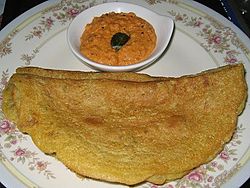Pesarattu facts for kids

Pesarattu
|
|
| Course | Breakfast, snack |
|---|---|
| Place of origin | Coastal region of Andhra Pradesh, India |
| Region or state | Andhra Pradesh, India |
| Main ingredients | Green gram |
Pesarattu is a popular and tasty dish from Andhra Pradesh, India. It's a bit like a thin pancake or a crepe. Pesarattu is a special kind of dosa.
What makes it unique? It's made from a batter of green gram (also known as moong dal). Unlike other dosas, it doesn't use a different bean called urad dal. People in Andhra Pradesh often eat Pesarattu for breakfast or as a snack. It's usually served with a flavorful ginger chutney or tamarind chutney. Sometimes, green chilies, ginger, and onions are added for extra taste.
Contents
What is Upma Pesarattu?
Sometimes, Pesarattu is stuffed with a dish called upma. This special version is known as Upma Pesarattu. It's very popular in cities across Andhra Pradesh.
Upma Pesarattu is a favorite in the Coastal Andhra region. You'll find it especially loved in areas like West Godavari, East Godavari District, Krishna district, and Guntur District. It's also a big hit in cities like Guntur and Vijayawada, and in the Visakhapatnam District.
Other Similar Dishes
Pesarattu has some cousins in other parts of India! In North Indian cooking, you might find similar dishes called moong daal ka cheela or besan ka cheela. These are also pancake-like and made from different types of lentil flours. In Rajasthan, these dishes are often called cheeldo.
How to Make Pesarattu
Making Pesarattu is not too hard, but it needs a bit of care to get the perfect taste and texture. Here's how it's generally made:
Soaking the Gram
The first step is to soak the "pesalu," which are whole green gram beans. You need to soak them in water for at least four hours. You can soak them for up to seven hours. About 150 ml of gram can make four medium-sized Pesarattus.
Grinding the Batter
After soaking, the gram is ground into a smooth paste. A few green chilies, a small piece of ginger, and some salt are added to the mix. Water is added slowly until the batter reaches the right consistency. The mixture then sits for a few minutes. This helps the gram grains soak up all the water properly.
Cooking the Pesarattu
The batter is then poured onto a hot pan. If it's made just right, the Pesarattu will slowly become crispy around the edges. It will also start to lift off the pan easily. In restaurants, the pans are very hot, so the Pesarattu usually doesn't need to be flipped. At home, people often flip it to make sure it cooks completely on both sides.
Adding Toppings
Sometimes, chopped onions and chilies are sprinkled over the batter while it's cooking on the pan. This adds extra flavor and crunch. As mentioned before, upma can also be spread on top of the batter. In some places, people even add both upma and onions to their Pesarattu!
See also
 In Spanish: Pesarattu para niños
In Spanish: Pesarattu para niños

